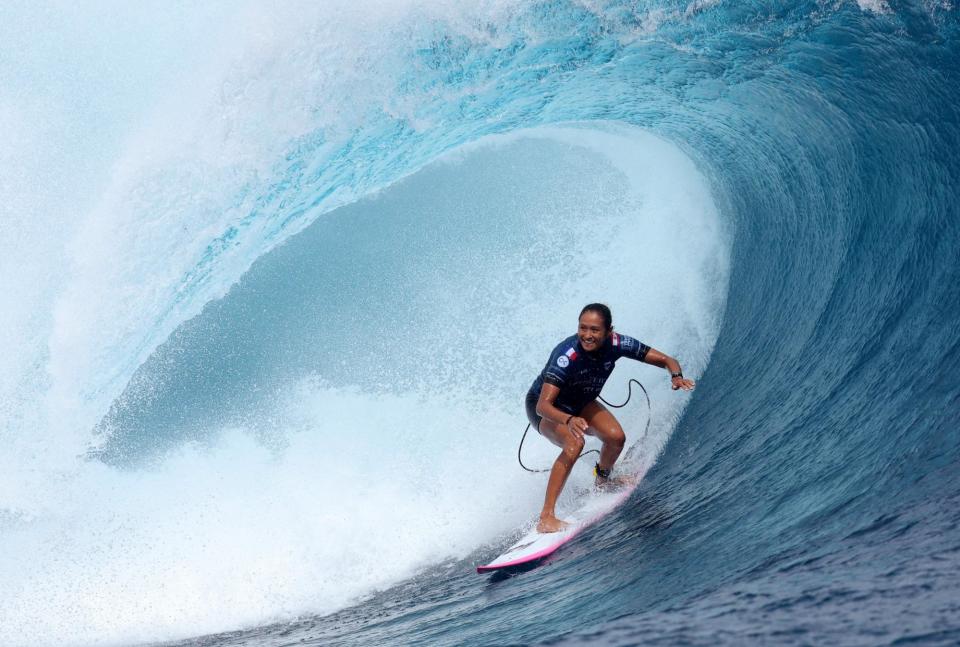‘Teahupo’o is for the women after all’: flawless surfing vindicates push for gender equality

Asked two years ago about the advancement towards gender equality in surfing, Australia’s Tyler Wright told the New York Times that “it takes a lot of minor, small, minute shifts for progress to really happen”. But sometimes, those incremental steps culminate in a decisive moment. Change, to paraphrase Ernest Hemmingway, can come gradually and then all at once.
Related: ‘I’m frothing on it’: Australia’s next big surfer George Pittar soaks in new success | Kieran Pender
This week, that moment came for women’s surfing. In heaving eight to 10ft swell at Teahupo’o in Tahiti, renowned as one of the most fearsome waves in the world, the best female surfers put on a spectacular show. “Teahupo’o is for the women after all,” exclaimed event winner Vahine Fierro, following one of the most exhilarating days of competitive surfing in the sport’s history.
The World Surf League (WSL) has been on a journey towards gender equality in recent years, shaking off its reputation as a sport filled with sexism. In 2018, the governing body announced equal prize money for every WSL-controlled event. In 2022, the sport moved to a fully integrated world tour, meaning the men and women compete in the same location, in the same competition window, at every event (previously there were some joint events and some distinct events).
This shift has been most noticeable in waves of consequence – heavy, barrelling waves over shallow reefs – which had long held men’s competitions while the women surfed elsewhere. The lack of competition opportunities in such waves meant the best women’s surfers trained less frequently on these waves, and had fewer opportunities to demonstrate their tube-riding prowess.
A fatal shark attack changed that. Previously, during the Hawaiian leg of the WSL, men surfed at Pipeline – considered alongside Teahupo’o as one of the most notorious waves – while the women surfed at Maui. But at the start of the 2020-21 season, a shark attack at the women’s contest site meant they could not finish the competition on that wave. WSL competition director, Australian Jessi Miley-Dyer, offered an alternative: the women could finish at Pipeline instead.
Following a meeting among the surfers, the group decided to go ahead with the switch. “It’s one that we will look back on as changing the trajectory of the sport,” Miley-Dyer later reflected. “We all walked away from that meeting knowing that it would change women’s surfing forever.”
If the shift to Pipeline was a landmark moment on the road towards gender equality in surfing, Thursday’s fireworks in Tahiti marked the next. Teahupo’o is an almost spiritual location for world surfing, “the end of the road”, an iconic, fear-inspiring wave. Tahiti has for decades hosted a leg of the WSL, and in the past women competed there from time to time.
But a decision was made in 2006 to discontinue the women’s event at Teahupo’o, reportedly for fear of serious injury. “It’s a pretty sexist decision,” Australian surfer and three-time Tahiti Pro champion Melanie Redman-Carr said at the time. “If the men can go there, why can’t we?”
Almost two decades later, in 2022, the women finally returned. And on Thursday, in world class barrels, they showed they very much deserved to be there. Fierro, a local wildcard, looked in sync with the ocean all day. Costa Rican Brisa Hennessy displayed the skills that saw her deservedly return to world No 1.
Related: ‘Losses have made me hungrier’: the New Zealand surfer chasing Olympic gold at Teahupo’o
Exceptional surfing reached its pinnacle in the second semi-final, as Fierro duelled with Brazil’s Tatiana Weston-Webb. The local effortlessly pulled into barrel after barrel, quickly collecting a pair of eight out of 10s. With her back against the wall and just five minutes remaining in the heat, Weston-Webb took off late and deep into a heavy slab, disappearing into the spray – before miraculously re-emerging with her arms aloft. All five judges awarded a perfect 10, elevating Weston-Webb into the lead.
But even that flawless effort would not be enough. Fierro answered back with less than a minute on the clock, earning a 9.63 and progressing to the final, which she ultimately won. The semi-final was quickly dubbed the best-ever heat in women’s surfing. And it was vindication for those who had said all along that women belonged at Teahupo’o.
Fierro acknowledged the role of Miley-Dyer in moving the sport forward. “Thank you to Jessi for trusting the women because we were more than capable out there,” she said. It is perhaps no coincidence that Miley-Dyer, a former professional surfer, competed at Teahupo’o in 2006 before the women’s edition went on hiatus.
Of course there is more progress to be made. Despite equal prize money and an equal schedule, the women’s WSL field is significantly smaller than the men’s – after the mid-season cut, there are just 10 women left on tour, compared to 22 men. Commercial opportunities still disproportionately benefit male surfers. And while the WSL is no longer quite so blatant in prioritising good conditions for the men’s competition over the women, sometimes the timing and sequencing of heats still raise question marks.
After decades of underinvestment and limited opportunities for women’s surfing, true parity in the sport will not come overnight. But Thursday’s action was nonetheless a significant moment. Following plenty of “minor, small, minute shifts” in recent years, progress towards gender equality was suddenly crystalised as elite female surfers fearlessly charged one of the globe’s most testing waves.
Progress had come gradually, and then on Thursday suddenly. And with the surf world returning to Teahupo’o for the Olympics in less than two months’ time, there is plenty more to come.

